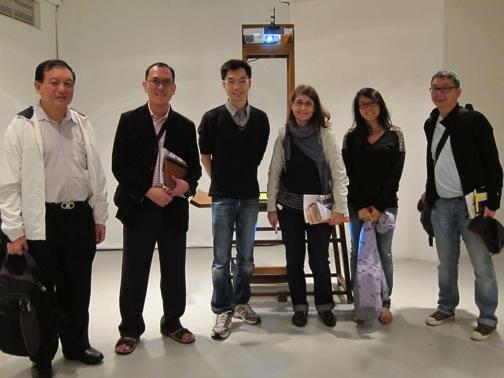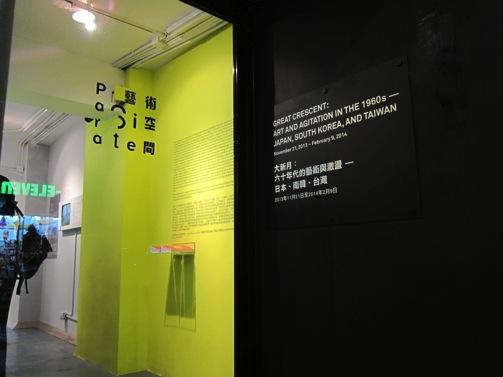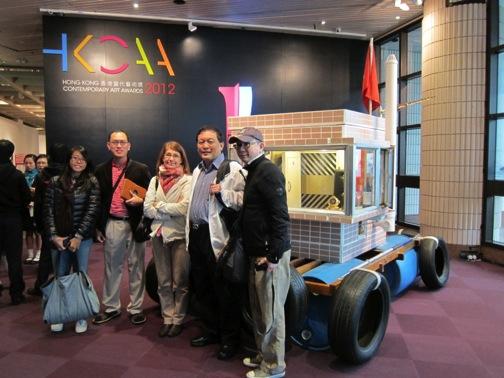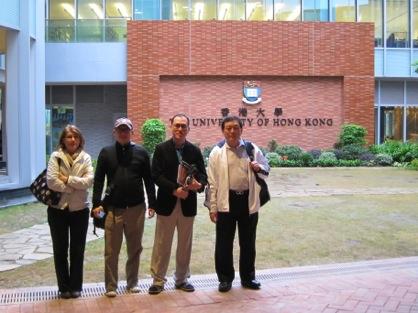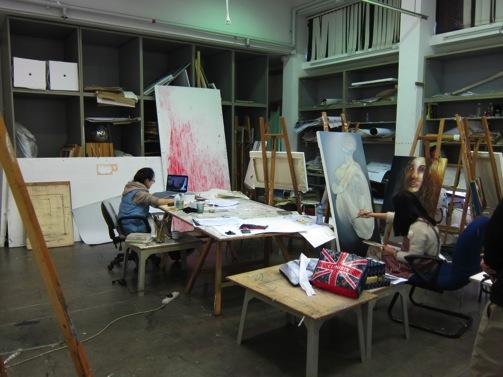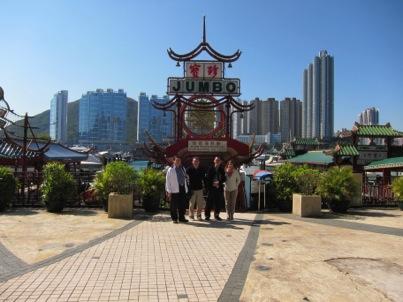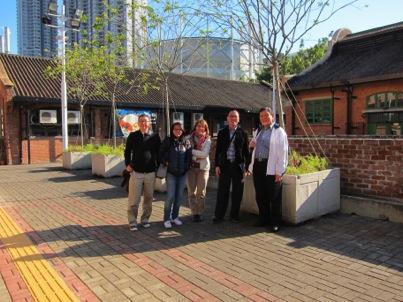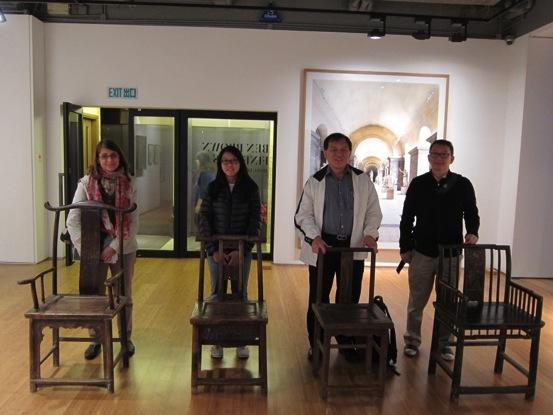by Marie-Pierre Mol
When the decision was taken to go to Hong Kong for the study trip, my classmates and I were looking forward having a good time in a city that we had already previously explored. However, to our pleasant surprise, this study trip was an opportunity to discover unexplored cultural territories. In Hong Kong, like in Singapore, land is scarce and thus expensive, and exhibition spaces are limited. Despite this drawback, many independent, non-commercial alternative art spaces have existed side by side with glitzy commercial galleries and public museums.
Day 1
The Hong Kong Arts Centre is a non-profit organisation and a self-financed statutory arts organisation established since 1977. Located in a beautifully designed building, the Hong Kong Arts Centre not only hosts innovative exhibitions of contemporary art but also educational institutions like the Goethe Institute and commercial spaces. We had the opportunity to visit Distilling Senses, an amazing journey through art and technology in Asian contemporary art. In this exhibition, nine Asian artists (Wang Ningde, Team Lab, which also showcased at the SB 2013, Shilpa Gupta, Lee Yongbaek, Chang Yung Ta, Takashi Ishida, Wong Chung Yu, Nam June Paik, Samson Young) explore how technology shapes art and how artists use technology to sharpen our senses and enhance understanding of our surroundings.
Para Site, an established private art space located in Hollywood Road, hosts exhibitions and organises residency programmes for artists, writers and curators. Para Site publishes PS, a magazine, dedicated to visual arts and culture, books and exhibition catalogues. The on-going exhibition was Great Crescent: Art and Agitation in the 1960s- Japan South Korea and Taiwan which featured photos and videos by early avant-garde East Asian artists. Until recently, Para Site has been financed by the Government of Hong Kong Special Administrative Region but there is no guarantee for Para Site to get this financing in the long run.
Day 2
Founded in 2000, Asian Art Archive (AAA) is a private initiative which was launched to compensate for the lack of resources on Chinese contemporary art. It is research driven and its motto is “preserving by sharing”. Today, the scope covered by AAA covers all of Asia, from Pakistan to the Philippines, from China to Singapore. Its programmes encompass various kinds of research projects such as archiving artworks in alternative art space, like Salon Natasha in Hanoi, residency programmes, and organizing “mobile library” projects in countries like Sri Lanka (2012) or Myanmar (2014) where cultural resources are scarce.
The Hong Kong Museum of Art, located on beautiful Hong Kong Bay, has a rich collection of calligraphy and traditional Chinese paintings. We were privileged to see temporary exhibitions showcasing treasures from the 17th century as well as cutting edge artworks from the Hong Kong Contemporary Awards 2012.
Without the prospect of the evening Chinese banquet, one of our classmates, who is a Chinese painting lover, would have never left the museum!
Day 3
The third day was dedicated to the visit of Hong Kong universities to learn about their art history programmes and to visit their museums and bookshops. It was a great opportunity to put our Masters programme into perspective.
We started with the University of Hong Kong, which was founded by the British in 1910 and is the oldest tertiary education institution in Hong Kong.
Located in a beautiful old mansion, the University museum and art gallery is also the oldest museum in Hong Kong. The latter was founded in 1953 to keep and display a collection of Chinese art and archaeology for teaching purposes. We met with the Chair of the Fine Arts Department and was surprised to find out that it only offers history and theory courses and not studio-based ones. The focus was different at the Chinese University of Hong Kong where we were offered a visit to students’ studios before going to the museum. It was a great pleasure to meet young artists in the midst of their creation process.
Day 4
We thought that we had already discovered the most exciting places and exhibitions of the city. However, our Programme Leader, Jeffrey Say, had prepared a grand finale. After being warmly welcomed by the managers of two non-profit art spaces, Spring Workshop and Videotage, both located in unconventional and unexpected locations of the city, we headed to the most prestigious international galleries and to the much anticipated new contemporary museum of Hong Kong, M+.
As a pleasant transition, between these two opposite worlds, we stopped for a delicious lunch in the Aberdeen Marina, where luxury yachts have replaced the traditional junks and sampans.
Opened in 2012, Spring Workshop is a beautifully designed art space anchored in an industrial neighbourhood of Hong Kong. This creative and innovative institution focuses on international cross-disciplinary programmes of artists and curatorial residencies, exhibitions, music, films and talks. Some of its projects are developed in collaboration with Para/site. Our group particularly enjoyed and identified with the concept of an Installation called “The Social Contract, A Constructed World ”. Among the texts included in the installation we meditated on the quote of Frances Ferguson, “A group seems most completely a group when the individuals in it share a maximum number of beliefs….’’
Videotage is a non-profit organisation dedicated to the promotion, presentation, creation and preservation of video art. It was created in 1986, with support from the support of Hong Kong Arts Development Council. Its location in a former slaughterhouse, known as the “Cattle Depot Artist Village”, makes this art space particularly attractive.
After this exploration of the most cutting edge art spaces, we could not miss what Hong Kong is famous for, namely its high end art market. In Central, at 12 Pedder Street, the 301 Pedder Building houses the most prestigious international Gallery such as Gagosian, Pearl Lam, Lehmann Maupin, Simon Lee and Ben Brown. In the latter, we particularly enjoyed the exhibition called EXPRESSION: A Philosophical Portrait of Human Kind, works selected by Martin Klosterfelde. The photo of our group, with each one of us standing behind a Qing Dynasty chair by Ai Wei Wei, testifies to this!
We had no time to climb the Peak but the peak of our visit was the presentation of the M+ project. M+ is a gigantic museum project aimed at becoming both an iconic building and cultural concept in Hong Kong. This museum is dedicated to twentieth and twenty-first century art, design, architecture and film. It will be located on Hong Kong’s Victoria Harbour, in West Kowloon and should be completed in 2017.
Much more could be said about the good time we had enjoying the food, “book hunting” and debating on every possible subject matter. In a nutshell, despite the terrible December weather, which was cold and rainy, the Hong Kong study trip will remain one of the best memories of this Masters programme.
This article was written by Marie-Pierre Mol, who is currently a student of the MA Asian Art Histories Programme. All photos courtesy of Derelyn Chua


